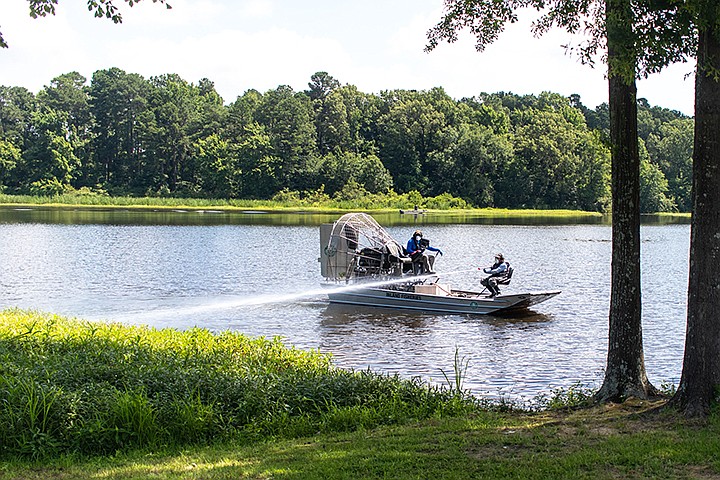TEXARKANA, Texas - Herbicide and native plants are containing the growth of giant salvinia in Bringle Lake, and officials are looking forward to winter for a chance to make progress in killing as much of the invasive plant species as they can.
Since beginning their battle against Bringle Lake's salvinia in June, specialists with the Texas Parks and Wildlife Department have visited the lake twice to spray with herbicide, said John Findeisen, leader of TPWD's Aquatic Habitat Enhancement Team. The effort has reduced the surface area covered by salvinia from 9 acres to 8 acres, and native plant species are helping to corral the plant, as well.
The native plants are also a hindrance, though, as TPWD does not want to risk spraying them, too. That's why the plan is to hold the salvinia in check until winter, when the native plants will die off, clearing the way for TPWD to "come back and hit it hard," Findeisen said.
TPWD plans to spray at the lake at least once a month September through November and then make further plans for the winter.
Calling the free-floating fern "one of the major threats to aquatic ecosystems in Texas," TPWD announced in June that giant salvinia had been found in Bringle Lake, the centerpiece among a group of parks and trails in the northern part of the city.
Under ideal conditions, giant salvinia can double in size in less than a week. It forms thick mats of foliage on the surfaces of bodies of water, preventing light and oxygen from reaching any animals or other plant life beneath.
"It creates an aquatic desert," Findeisen said. "Nothing else can live there."
Left unchecked, giant salvinia also prevents water recreation, making fishing, boating and swimming impossible.
The problem is most common in East Texas north of Houston, though salvinia has invaded waters in Victoria County in South Texas, too. With only a couple of exceptions that have required extra attention, Findeisen's six-person team has held its own against salvinia statewide this year.
"It hasn't gotten out of control," he said.
For example, TPWD has sprayed 9,000 acres of salvinia on Caddo Lake in Northeast Texas in 2020, but that amount did not significantly change since last year.
TPWD urges anglers and other boaters to thoroughly clean, drain and dry their boats and other equipment after use to prevent spreading giant salvinia - and other invasive species such as zebra mussels - from one body of water to another. Hunters, too, should follow clean, drain and dry protocols, as invasive species can be spread via gear such as duck decoys, Findeisen said.
Transporting prohibited invasive species in Texas is illegal and punishable with a fine of up to $500 per violation. Boaters are also required to drain all water from their boat and onboard receptacles, including bait buckets, before leaving or approaching a body of fresh water.
(For more information on how to properly clean, drain and dry boats and equipment, visit the TPWD YouTube channel for a short instructional video. To learn more about common and giant salvinia along with other invasive species in Texas, visit tpwd.texas. gov/landwater/stop-invasives/. The department recommends that Texans who have frequent contact with bodies of water should learn to identify invasive species, and if they spot any they should report the sighting to TPWD at 409-698-9121, Ext. 235, or by emailing photos and location information to [email protected] .)

